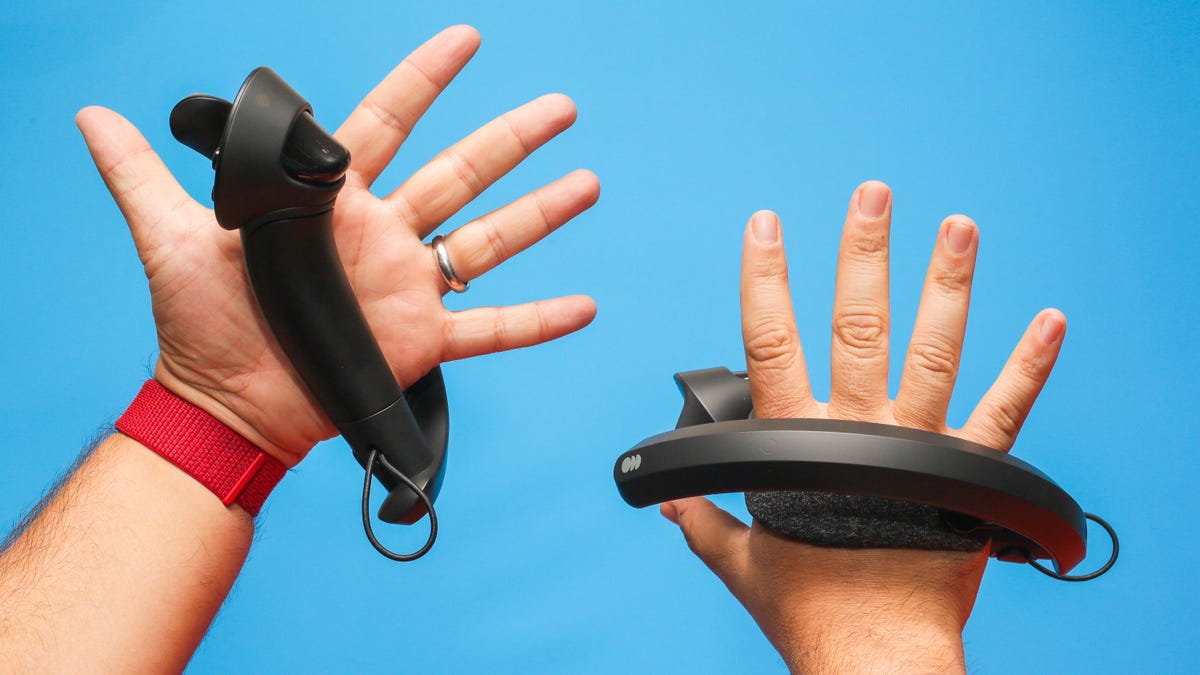Valve Index's new VR controllers feel like the future of gaming
The most interesting feature in Valve's new virtual reality system is how its controllers work in your hands.

I'm high-fiving a robot. I make a fist. I stick up my middle finger. I see my fingers wiggle on the virtual hands in front of me, all five digits. It's almost like wearing virtual gloves.
Setting up a VR system isn't a new thing for me. I'm used to putting on headsets and diving into new worlds. But every once in a while, there's something surprising that changes the game. Valve Index, a new high-end VR system arriving soon, does that with its unique controllers.
I've set up the Valve Index here in CNET's New York office, and have just been using it for a few days (the system arrived when I was in Toronto last week, so I'm catching up fast). It has a nice high-resolution display, and a larger-than-typical field of view.
But what does Valve's newest VR hardware do for a PC landscape that already has the Oculus Rift S, plenty of Windows VR headsets, and the HTC Vive?
It's all about the controls.
If you've ever used any PC-connected VR before, Valve Index is mostly a familiar proposition: it works with Steam VR (no surprise), and the hardware is also compatible with the HTC Vive "lighthouse" sensor boxes, which is helpful.
The Valve Index headset and controllers.
The kit I received has the Valve Index VR headset, two "Knuckles" Index controllers, and two Base Station 2 sensors, which can track a larger maximum play area than the original base stations.
The Valve Index controllers are totally odd-looking, but make a lot more sense when put on. They're nicely designed: a comfy padded band stretches across the back of my hand, and a button adjusts an elastic cord to keep it snug. The plastic grip and buttons perched on top, with triggers, feel like an evolved version of the Vive's controllers.
But the grip, and the elastic band, mean I can let go of my hands, and wiggle my fingers, and each finger is tracked separately. I can point, use two, three or four fingers, make a fist, do whatever. I don't even have to hold the controllers: I can let go completely and they'll stay attached to my palms.
The Index controller stays in my hand thanks to a back strap. There's a trigger, buttons, a stick and a touchpad, too.
In games I've tried so far, they work like a better version of what Oculus Touch controllers aim for. The Touch controls always impressed me because they function like a standard game controller (buttons, triggers, analog sticks), but can sense finger proximity, allowing a finger to point, or giving a thumbs-up if I raise my thumb. The Oculus Touch only works for three fingers, though, and still requires holding the controller while moving those fingers. The Valve Index controls allow much freer finger motion.
One of Valve's demo apps, Aperture Hand Lab, is a perfect little intro to how the controls work. I'm thrown into a falling-apart slice of Valve's Portal universe, where a robot eyeball with arms encourages me to interact. I give a high-five, I play rock-paper-scissors. I rip the robot's arm off while giving a strong handshake.
The Valve Index controller (center) next to the HTC Vive controller (left) and Oculus Touch (right). It feels like a fusion of both, and more.
The Valve Index controllers can sense force as well as motion, so I can grip harder and have it register. Another game demo, Moondust, puts me on a moon surface where I pick up rocks, then crush them by squeezing -- or, grab a grenade and squeeze to trigger its timer. The Valve Index controllers have vibrating haptic feedback: it doesn't seem so super-realistic that it reflects a range of sensations, but the buzzing helps offer some sense of "touch."
A climbing game (called "Climbey") also shows off the Index controls a bit. I ball up my fists and swing my arms to jump, or grab on a climbing surface with my fingers. Sometimes, my finger positions seem to wobble a bit. The software is still early, and Valve is updating apps to be Index-compatible. I'm really curious what these controllers could achieve in creative apps.
The flip-down side speakers on the headset float off the head, and sound booming.
The headset, by the way, has great audio. Off-ear headphones are booming and crisp. The 130-degree field of view feels more expansive than a typical Vive or Oculus Rift, but not as stunningly different as you might expect. (The headset's design was also a bit tight on my glasses, even after adjustment.)
I played Beat Saber (of course), and everything looked and controlled great. The faster refresh rate of the Valve Index headset (120Hz or an experimental 144Hz instead of a more standard 90Hz) doesn't always come into play in all games, and it's sometimes hard to appreciate (honestly, most good VR already feels pretty smooth and fluid). The 1440x1600 per eye resolution (the same as Oculus Quest, surprisingly) looks good, but it's the extra field of view that really makes things seem to pop. One thing to note: the Index doesn't have eye tracking.
Another thing Index doesn't do (yet) is wireless. The long tethered cable to the desktop PC needs to plug into DisplayPort and USB, and has a breakout for the AC adapter. It's no different than the Vive or Oculus Rift, but I've been spoiled lately by the wireless freedom of the standalone Oculus Quest.
I'll have a full review of Valve Index in the future. For now, I'd say the Index feels most like a true Vive sequel, but in Valve form.
And the controllers that appear to be the product's biggest game-changer.

